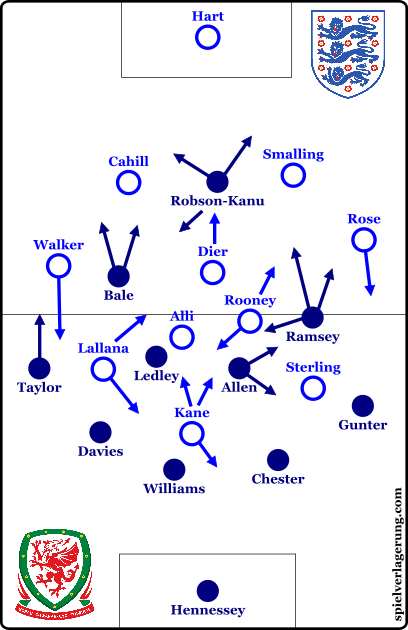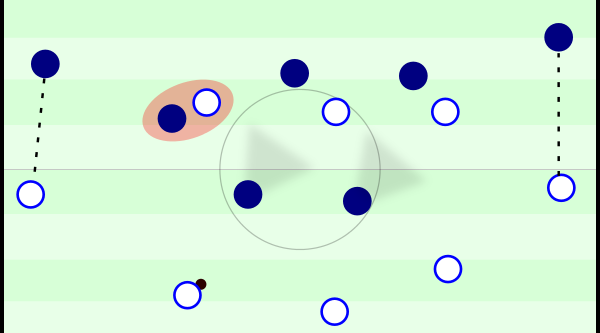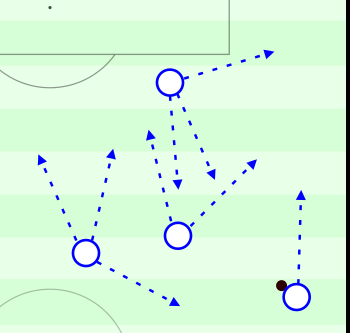England recover from a goal down to beat Wales
In one of the most well-anticipated matches of the European Championships so far, England took on Wales in a pivotal Group B clash. England lined up with an attacking set of personnel, with Wayne Rooney and Dele Alli again in midfield.  This was further exacerbated as Roy Hodgson brought on three strikers over the course of the match. Chris Coleman’s team elected to continue with the 5-4-1 they have used consistently, but used a number of different pressing patterns throughout the game.
This was further exacerbated as Roy Hodgson brought on three strikers over the course of the match. Chris Coleman’s team elected to continue with the 5-4-1 they have used consistently, but used a number of different pressing patterns throughout the game.
Stagnant England build-up
Despite expectations that Wales would attempt to press England high, this was often limited to an initial counterpress. If the ball was not won back immediately then the block would deepen and less pressure was applied to the English ball-carrier. Much of this aggression was governed by Aaron Ramsey, who had an interesting role in transitioning from a front three in attack to a midfield three when out of possession. He often had to drop into the most easily-available position in the three, meaning Ledley & Allen were expected to adapt to his positioning, particularly when England had possession. Against a team with more co-ordination in attacking small spaces in midfield, this may have created problems, but England were unable to do so.
Even despite the lack of pressure applied early, England struggled to deal with even basic Wales man-orientations. Eric Dier unnecessarily dropped deep to form a situational back three, and Wayne Rooney & Dele Alli were unable to create consistently available passing options when they were man-marked.
Wales were easily able to shift laterally when the ball was circulated across the England backline, and any of the three midfielders could move with their man if they make a sharp movement towards the ball.
Often Harry Kane was forced to drop deeper and create a temporary 4v3 in that midfield area, forcing Joe Allen to cover two players. This initially caused problems for Wales’ man-orientations, but they moved more into a zonal structure as the game progressed. Once this happened, England found more success building on the right-side, where the movement patterns of Harry Kane & Adam Lallana were difficult for Wales to deal with. Kane’s natural inclination is to drop deeper, and Lallana is intelligent enough to react to this movement with an appropriate action of his own. Kane dropping deep to receive the ball and allowing Lallana to move beyond him created the key transition opportunity that Raheem Sterling was unable to finish.
This was more often used in attacking organisation though, where England had more success building down the right.
Despite making a move into a less dangerous area of the pitch, Kane was able to successfully exploit the man-orientation of Ben Davies to create room in the halfspace for Adam Lallana to move into.
England also found some success at inverting these movements in order to create room for Walker to overlap in wide areas. This meant Adam Lallana starting on the wing before drifting inside, and Kane making a forward-diagonal movement in the halfspace. Combined with lots of horizontal ball circulation from Wayne Rooney, Kyle Walker was given lots of 1v1 opportunities against Taylor. These found little success, but were more effective when combination play was created with Kane or Lallana.
England aggressively man-orient
It was rare that Wales attempted to build play from the back, and this was partly due to England’s aggressive man-marking. The front three would align themselves with the Wales back three, and Walker & Rose would push forward to the Wales wing-backs. With Ramsey in a more advanced build-up position, this forced long balls forward. Only once or twice were the central defenders able to make an accurate ground pass to Ramsey, and even then he was unable to quickly turn and attack the vacant space.
Later in the half the aggression of this man-marking was reduced as England chose not to continue pushing both full-backs forward so far. But with two forwards closing the three Wales’ central defenders, they were able to force them into using any passing lane they wanted. Particularly due to the lack of press resistance in Wales’ backline, it was often left to Joe Allen to win an individual 1v1 deep in his own half upon receiving the ball facing his own goal.
Half time changes
At half-time, Hodgson elected to bring on Daniel Sturridge and Jamie Vardy, as Sterling and Kane were taken off. Initially it seemed as if they would retain the 4-3-3 shape utilised in the first half, but Lallana was given a less restrictive role, and Sturridge spent much of his time away from the right wing.
The Wales wing-backs began to sit deeper, and the 5-4-1 no longer pendulated on the ball-side. This meant the three central midfielders were expected to cover the entire width of the pitch. Wales began to drift deeper and shift slower laterally, meaning England could progress play with good horizontal passing speed. This allowed Wayne Rooney to utilise his quick diagonal passing in a more effective way, by creating wide 1v1s for England’s full-backs as their wingers moved into more central positions.
Often Sturridge would drop to the halfspace where he could confront the outside central midfielder of Wales in an individual duel, with much higher fitness levels than his opponent. Because of the very high positioning of Walker in the final minutes, Sturridge was able to follow his horizontal pass to the other side of the pitch and overload the right side of Wales’ defense. As Wales’ ball-orientation lessened, a [small] space appeared for tight combination play with Dele Alli, and Sturridge scored the last minute winner.
Conclusion
Despite coming from behind, a victory does not flatter England. Hodgson was able to make two successful half-time changes and create an ultra-attacking team that Wales were simply not able to deal with. Whilst Eric Dier made poor contributions to England’s early build-up play, he was able to reduce Gareth Bale’s availability in transition once the ball reached Wales’ half. This reduced the Real Madrid man’s contribution to a long-range free-kick.


2 Kommentare Alle anzeigen
travis June 18, 2016 um 8:32 am
i still can’t figure out why Hodgson chose 433 rather than 4231.Players in Spurs ,Man Utd,Man city are surely familiar with 4231.the Rooney issue? Rooney has no ability to play as an AMC so Hodgson created a 433 in which Rooney seems can play as a deeplying mid like Modric? if Hodgson stick to 433 in which Kane play as a so called hold-on forworad,why didn’t he firstly send on Sturridge to shoot ? what a out of date manager.
Rovazzz June 17, 2016 um 3:15 pm
Great analysis, and thank you for taking the time to put this together.
You highlighted Dier’s lack of contribution to England’s build-up from the back, specifically his tendency to drop between Smallling and Cahill to make a back three. I think his movements are in response to the fullbacks, Walker and Rose tendency to push higher up the pitch. We saw him
make similar moves with Spurs. It’s clear that Roy has taken a page out of Pochettino’s book to accommodate Walker, Dier, Rose, and Kane. However, Rooney and Alli are not natural Pivots, hence why England struggled in the build up. I think Roy needs to stop being so pragmatic and go with a lone striker.